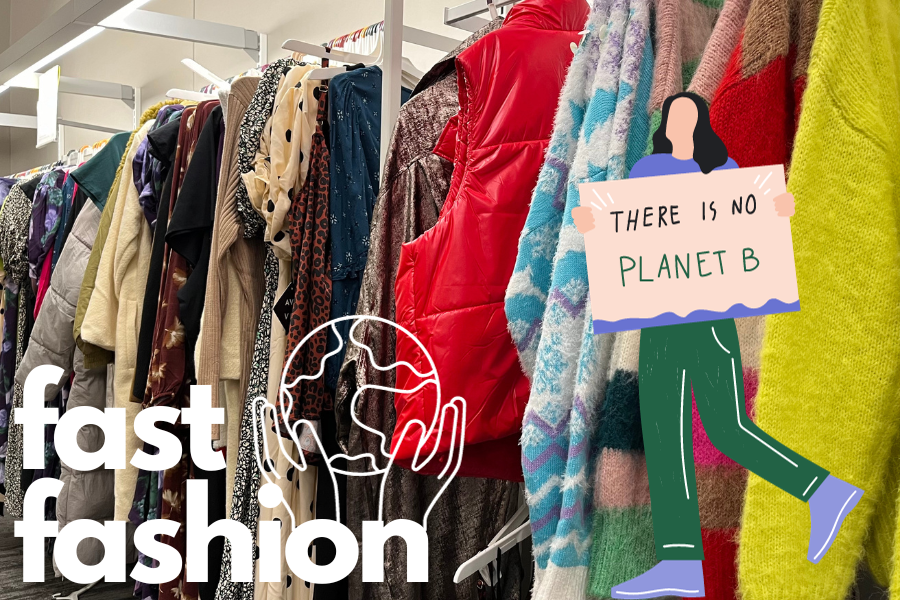The clothing industry has drastically changed how it manufactures clothing, transitioning to large-scale production in recent years. This business is a strategy for apparel manufacturers to gain profit by getting trendy styles replicated and on racks quickly.
Rapid production for high-demand trends results in using cheaper materials and overall low-quality attire. Materials that go into making sustainable clothing include cotton, hemp, bamboo and linen.
In contrast, materials used in unethical clothing are nylon, acrylic, elastane and particularly, polyester, a synthetic fiber made from mixing ethylene glycol and terephthalic acid and is better known as plastic.
The combination of low-grade materials and revolving trends allow for drastically limited consumer usage; therefore, mounds of these products end up in landfills and pollute the air through incineration.
Recent Southeastern alumna and graphic designer Elana Guillory said, “There are products you can make with smaller ecological footprints than others. For example, t-shirts from [Gildan’s] Comfort Colors may be more pricey, but they are a member of the U.S. cotton trust protocol and their stuff is made from 100% ring spun cotton, which is better for the environment.”
Based on studies from the Center for Biological Diversity, “waste occurs at every stage of the garment manufacturing process, harming wildlife, degrading land and polluting soil and water.”
The microfibers and dyes used to make clothing are toxic and eventually end up dispersing into waterways to later be consumed by both marine and land animals, eventually resulting in consumption by humans.
“The fashion industry is the second-largest industrial polluter, accounting for 10% of global pollution, ranking higher than emissions from air travel,” according to the Carbon Literacy Project.
Along with the disastrous effects fast fashion has on the environment, the workers behind the industry are immensely exploited. Defined by the U.S. Department of Labor (DOL), a sweatshop is “a factory that violates two or more labor laws.”
Sweatshop conditions are arduous and include 14 to 16 hour days, unfair wages, unhygienic stations, harmful substances and, oftentimes, child labor.
Lei Nguyen, a writer at Earth.org, wrote a “large number of sweatshops are located in poor nations with weak labor laws and little government control; as a result, if workers attempt to challenge their rights or work conditions, they risk losing their jobs.”
According to the Common Objective, the lack of protection and care for workers results in “1.4 million injuries in fashion industry workplaces each year.”
A notable example reflecting the lack of concern for worker’s safety happened in 2013, when 1,134 lives were lost in Bangladesh’s Rana Plaza after it collapsed from inadequate building materials used for the foundation.
Brands such as Shein, Forever 21, Fashion Nova and Zara are categorized as “ultra fast fashion” because of their immense popularity and unethical practices.
Mona Jahani, an assistant professor of costume design at Southeastern, said, “If fast fashion is all you can afford, try to avoid numerous smaller purchases of trendier pieces that might only get a few wears before they fall out of rotation in your closet. Try to think of pieces that can be mixed and matched into multiple outfits for multiple uses.”
Though some of the most favored brands worldwide produce unsustainable clothes, there are ways to avoid them and build a greener closet. Thrifting clothes from second-hand clothing stores has had a sizable impact on reducing waste and is a way to get quality clothing for cheaper prices.
“From a costume design perspective, we have to be conscious of how we source clothing items for productions. Sometimes there isn’t the time or budget to avoid fast fashion entirely, but it’s a choice we have to try and make as responsibly as we can,” Jahani said.
Fast fashion is a constantly expanding industry that won’t cease in continuing to harm the environment. Shopping locally, borrowing or renting clothes and conducting research into this sect of consumerism not only helps one’s clothing collection to become more sustainable, but can contribute to lessening the effects of climate change and support the rights of garment workers.









